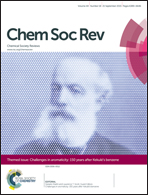Pro-aromatic and anti-aromatic π-conjugated molecules: an irresistible wish to be diradicals
Abstract
Aromaticity is an important concept to understand the stability and physical properties of π-conjugated molecules. Recent studies on pro-aromatic and anti-aromatic molecules revealed their irresistible tendency to become diradicals in the ground state. Diradical character thus becomes another very important concept and it is fundamentally correlated to the physical (optical, electronic and magnetic) properties and chemical reactivity of most of the organic optoelectronic materials. Molecules with distinctive diradical character show unique properties which are very different from those of traditional closed-shell π-conjugated systems, and thus they have many potential applications in organic electronics, spintronics, non-linear optics and energy storage. This critical review first introduces the fundamental electronic structure of Kekulé diradicals within the concepts of anti-aromaticity and pro-aromaticity in the context of Hückel aromaticity and diradical character. Then recent research studies on various stable/persistent diradicaloids based on pro-aromatic and anti-aromatic compounds are summarized and discussed with regard to their synthetic chemistry, physical properties, structure–property relationships and potential material applications. A summary and personal perspective is given at the end.

- This article is part of the themed collection: Challenges in Aromaticity: 150 Years after Kekulé’s Benzene

 Please wait while we load your content...
Please wait while we load your content...